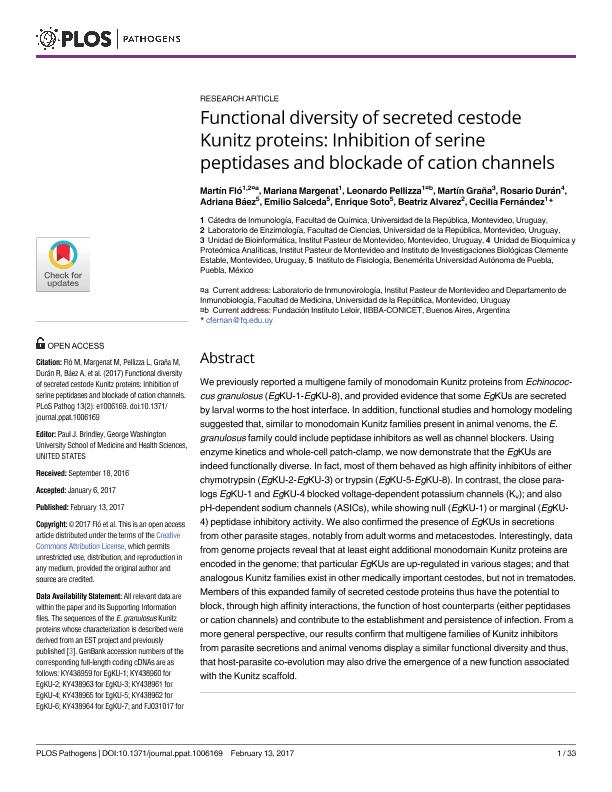Artículo
Functional diversity of secreted cestode Kunitz proteins: Inhibition of serine peptidases and blockade of cation channels
Fló, Martín; Margenat, Mariana; Pellizza Pena, Leonardo Agustín ; Graña, Martín; Durán, Rosario; Báez, Adriana; Salceda, Emilio; Soto, Enrique; Alvarez, Beatriz; Fernández, Cecilia
; Graña, Martín; Durán, Rosario; Báez, Adriana; Salceda, Emilio; Soto, Enrique; Alvarez, Beatriz; Fernández, Cecilia
 ; Graña, Martín; Durán, Rosario; Báez, Adriana; Salceda, Emilio; Soto, Enrique; Alvarez, Beatriz; Fernández, Cecilia
; Graña, Martín; Durán, Rosario; Báez, Adriana; Salceda, Emilio; Soto, Enrique; Alvarez, Beatriz; Fernández, Cecilia
Fecha de publicación:
02/2017
Editorial:
Public Library of Science
Revista:
Plos Pathogens
ISSN:
1553-7366
e-ISSN:
1553-7374
Idioma:
Inglés
Tipo de recurso:
Artículo publicado
Clasificación temática:
Resumen
We previously reported a multigene family of monodomain Kunitz proteins from Echinococcus granulosus (EgKU-1-EgKU-8), and provided evidence that some EgKUs are secreted by larval worms to the host interface. In addition, functional studies and homology modeling suggested that, similar to monodomain Kunitz families present in animal venoms, the E. granulosus family could include peptidase inhibitors as well as channel blockers. Using enzyme kinetics and whole-cell patch-clamp, we now demonstrate that the EgKUs are indeed functionally diverse. In fact, most of them behaved as high affinity inhibitors of either chymotrypsin (EgKU-2-EgKU-3) or trypsin (EgKU-5-EgKU-8). In contrast, the close paralogs EgKU-1 and EgKU-4 blocked voltage-dependent potassium channels (Kv); and also pH-dependent sodium channels (ASICs), while showing null (EgKU-1) or marginal (EgKU-4) peptidase inhibitory activity. We also confirmed the presence of EgKUs in secretions from other parasite stages, notably from adult worms and metacestodes. Interestingly, data from genome projects reveal that at least eight additional monodomain Kunitz proteins are encoded in the genome; that particular EgKUs are up-regulated in various stages; and that analogous Kunitz families exist in other medically important cestodes, but not in trematodes. Members of this expanded family of secreted cestode proteins thus have the potential to block, through high affinity interactions, the function of host counterparts (either peptidases or cation channels) and contribute to the establishment and persistence of infection. From a more general perspective, our results confirm that multigene families of Kunitz inhibitors from parasite secretions and animal venoms display a similar functional diversity and thus, that host-parasite co-evolution may also drive the emergence of a new function associated with the Kunitz scaffold.
Palabras clave:
Kunitz
,
Proteins
,
E.Granulosus
Archivos asociados
Licencia
Identificadores
Colecciones
Articulos(IIBBA)
Articulos de INST.DE INVEST.BIOQUIMICAS DE BS.AS(I)
Articulos de INST.DE INVEST.BIOQUIMICAS DE BS.AS(I)
Citación
Fló, Martín; Margenat, Mariana; Pellizza Pena, Leonardo Agustín; Graña, Martín; Durán, Rosario; et al.; Functional diversity of secreted cestode Kunitz proteins: Inhibition of serine peptidases and blockade of cation channels; Public Library of Science; Plos Pathogens; 13; 2; 2-2017; 1-33; e1006169
Compartir
Altmétricas



